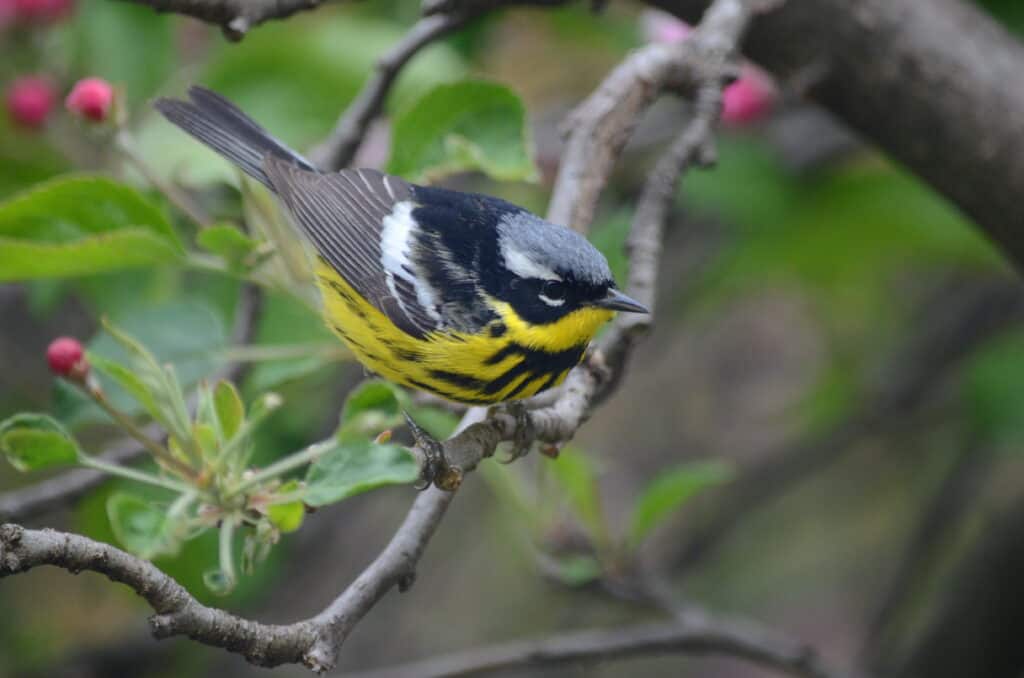Magnolia Warbler
Setophaga Magnolia
They line their nests with fungi strands
Advertisement
Magnolia Warbler Scientific Classification
- Kingdom
- Animalia
- Phylum
- Chordata
- Class
- Aves
- Order
- Passeriformes
- Family
- Parulidae
- Genus
- Setophaga
- Scientific Name
- Setophaga Magnolia
Read our Complete Guide to Classification of Animals.
Magnolia Warbler Conservation Status
Magnolia Warbler Facts
- Prey
- They mainly eat insects, including moths, beetles, and caterpillars.
- Name Of Young
- Chicks
- Group Behavior
- Social
- Pair
- Fun Fact
- They line their nests with fungi strands
- Estimated Population Size
- 39 million
- Biggest Threat
- Rising sea levels and spring heat waves
- Most Distinctive Feature
- Unique coloration
- Wingspan
- 6.3 to 7.9 inches
- Incubation Period
- 11 to 13 days
- Age Of Independence
- 25 days
- Age Of Fledgling
- 8 to 10 days
- Habitat
- lush forests
- Diet
- Insectivore
- Lifestyle
- Diurnal
- Favorite Food
- Moths, beetles, and budworms
- Type
- Bird
- Common Name
- Magnolia warbler
- Location
- North America, South America
- Average Clutch Size
- 4
- Nesting Location
- Dense conifers near the trunk's base
- Migratory
- 1
View all of the Magnolia Warbler images!
They search on the undersides of leaves for caterpillars.
The magnolia warbler is a long-distance migrant who passes through the United States on its way to wintering and breeding grounds. They inhabit lush forest habitats, hiding their nests and foraging insects while singing light melodies. Their unique coloration makes them easy to spot as they hop about on the outer edges of trees. Learn everything there is to know about this fantastic bird!
5 Amazing Magnolia Warbler Bird Facts
- Magnolia warblers spend their winters on cocoa plantations in Central America and the Caribbean Islands.
- They sloppily build poorly constructed nests, which they line with fine fungi strands.
- Males are highly vocal and like to sing while they work. You can often hear them during dusk and dawn.
- They migrate at night with other songbirds.
- They hide their nests deep within dense forest habitats, so predators have a more challenging time finding them.
Where to Find the Magnolia Warbler
The magnolia warbler lives in over 20 countries, including Canada, the United States, Mexico, Puerto Rico, and Jamaica. During the spring and summer, they breed in young, dense conifer trees, typically spruce further north and hemlock in the south. They prefer to forage in their lush forest habitats during migration, often staying close to the edge of a forest, woodlot, or park. This species is a little less picky on its wintering grounds and will inhabit cocoa plantations, second-growth forests, scrubs, orchards, and thickets.
The best time to watch these birds in the United States is spring and fall as they migrate to their breeding or wintering grounds. Look for them in the thick tree stands, lower to the bottom than most warblers. They like to forage on the outer edge of the tree, searching for insects on the undersides of leaves. Look for their signature black and white tails, which they regularly flash.
Magnolia Warbler Nest
Magnolias pick their nesting locations in dense conifers like spruce, hemlock, and balsam fir. These warblers place their nest less than ten feet above the ground near the trunk’s base on a horizontal branch. Males and females work together to build a somewhat poorly constructed nest cup made with grasses, weeds, and twigs. They line it with horsehair fungus, which is actually fine mushroom strands.
Scientific Name
The scientific name for the magnolia warbler is Setophaga Magnolia. Their genus name, Setophaga, translates to “moth-eating” in Ancient Greek, which refers to their diet. An American ornithologist first discovered this species in magnolia trees in Mississippi and consequently named them “Magnolia.”
Size, Appearance, and Behavior
The magnolia warbler is a moderately small bird, around the size of a sparrow and slightly larger than a kinglet. They measure 4.3 to 5.1 inches in length and weigh between 0.23 and 0.53 ounces with a 6.3 to 7.9-inch wingspan. You can distinguish this warbler by its unique coloration. Adult males are gray and black on top with white wing patches and bright yellow throats and bellies. Females and juveniles are primarily gray on the top, with white eye ring and a duller yellow on the bottom. Both sexes have the same tail patterning, white at the base and black at the tip.
Males are highly vocal, singing intensely during dawn and dusk, especially while foraging. They also use songs to court females and warn their groups of territory intruders. Males and females share a territory during breeding but live separately in winter habitats. They often join foraging flocks of chickadees during migration and will live with mixed species during the winter.

Adult male magnolia warblers are gray and black on top with white wing patches and yellow bellies.
©Bob Hilscher/Shutterstock.com
Migration Pattern and Timing
Magnolia warblers are long-distance migrants, choosing to fly under cover of darkness with other songbirds. They breed in the southern parts of Canada during spring and summer, migrate through the Eastern half of the United States during fall and early spring, and winter in parts of Mexico, Central America, and the West Indies.
Diet
Magnolia warblers are insectivores who search the undersides of leaves for their prey.
What Does the Magnolia Warbler Eat?
They mainly eat insects, especially during the breeding season when there’s an abundance. Their varied diet includes moths, beetles, caterpillars, leafhoppers, aphids, and spiders. They will consume large amounts of spruce budworms when there is an excess. During inclement weather, they will forage for berries. Researchers don’t know much about their winter and migration diet.
Predators, Threats, and Conservation Status
The IUCN RedList places the magnolia warbler as LC or of “least concern.” This species has an extensive range and a large population with increasing trends. Therefore, it does not approach a “threatened” status. But this warbler still faces threats from climate change and severe weather. Spring heat waves can endanger nestlings, heavy rainfall can keep parents from feeding their chicks, urbanization can demolish their homes, and rising sea levels can consume their coastal habitats.
What Eats the Magnolia Warbler?
While magnolia warblers take great care in hiding their nests deep within forest habitats, they and their young are still vulnerable to predators. Cowbirds are known for laying their eggs in these warbler’s nest, and the young may eject warbler chicks and eggs of their host. Hawks and other birds of prey will eat adults, and juvenile gray jays will capture, kill, and eat young magnolia warblers.
Reproduction, Young, and Molting
The males arrive on breeding grounds before the females and establish their territory. During courtship, males will woo females with their accented songs and show off their white tail spots. Once a pair forms, they share the breeding ground territory but typically live in separate areas during winter. Females usually lay four eggs, but it can range between three and five. The eggs are white with brown, lavender, olive, and gray markings. Incubation takes 11 to 13 days and is done solely by the female, but both sexes assist in feeding their young. Fledglings leave the nest between eight and ten days, but the parents may care for their young for an additional 25 days. Their average lifespan is two years, but they can live up to six years.
Population
The IUCN estimates 39 million mature individuals in the magnolia warbler population. There are no extreme fluctuations or severe fragmentations, and their numbers appear to increase slowly. Short-term data suggests their population is growing around 6% every decade.
Up Next:
View all 164 animals that start with MMagnolia Warbler FAQs (Frequently Asked Questions)
Where do magnolia warblers live?
They live in lush spruce and hemlock forests in Canada and the United States and inhabit tropical plantations and forests in Central America and the West Indies.
Where do magnolia warblers breed?
These warblers breed in the southern parts of Canada during spring and summer.
How big is a magnolia warbler?
They measure 4.3 to 5.1 inches in length and weigh between 0.23 and 0.53 ounces with a 6.3 to 7.9-inch wingspan.
What sound does a magnolia warbler make?
They produce a buzzy light melody, consisting of three short phrases with an accented ending.
Do magnolia warblers migrate?
Magnolia warblers are long-distance migrants, breeding in Canada during the spring and summer, migrating through the Eastern United States, and wintering in Mexico, Central America, and the West Indies.
What does a magnolia warbler look like?
Adult males are gray and black on top with white wing patches and bright yellow throats and bellies. Females and juveniles are primarily gray on the top, with white eyering and a duller yellow on the bottom.
How many eggs do magnolia warblers lay?
Females usually lay four eggs, but it can range between three and five.
Thank you for reading! Have some feedback for us? Contact the AZ Animals editorial team.
Sources
- IUCN Red List / Accessed September 6, 2022
- Oxford Academic / Accessed September 6, 2022
- JSTOR / Accessed September 6, 2022
- Ohio State University School of Environment and Natural Resources / Accessed September 6, 2022
- Searchable Ornithological Research Archive / Accessed September 6, 2022


















